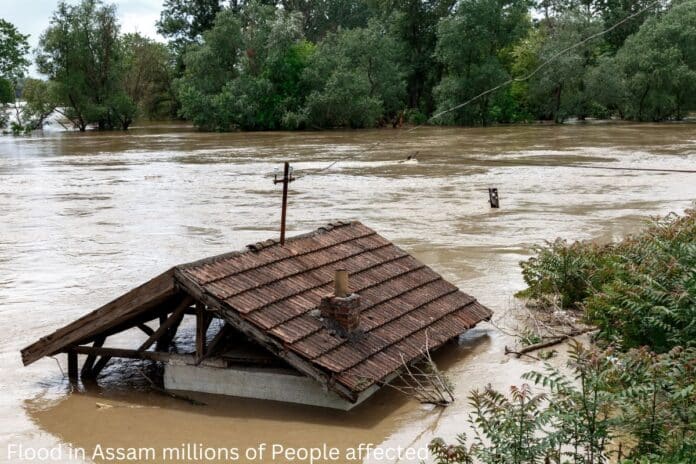The Assam flood situation in the State has worsened to such an extent that nearly 16.50 lakh people across 29 districts are heavily affected by it! The natural calamity has not only uprooted thousands of people but it also caused the authorities to face stiff challenges in providing relief and taking care of affected areas.
Current Situation
Till date,Assam floods have submerged countless areas with major rivers namely Brahmaputra and Barak crossing their safety levels leading to widespread havoc. The worst affected are key districts like Dhemaji, Lakhimpur, and Barpeta. The situation has also been aggravated by incessant rains, which continue to hamper rescue operations in several regions of the state. Immediate relief is being provided by the government in terms of the distribution of essential materials and setting up temporary shelters for displaced populations.
In many cases, they said that floods had submerged houses, agricultural land, and essential infrastructure causing thousands to be without the essentials. The destruction is more visible in the rural areas as floodwaters have carried away crops, leaving a gaping hole in the livelihood of farmers. In addition, heavily contaminated water sources pose a heightened risk of waterborne diseases threatening to worsen the health situation.
Government Response & Challenges
The Assam State Disaster Management Authority (ASDMA) and other government departments are engaged in relief measures. Construction of embankments and flood walls, river training, and anti-erosion works are currently being done to manage the impact. Still, the enormity of this disaster poses formidable hurdles to such efforts. Budgetary concerns and logistical challenges can impede the success of long-term flood management solutions.
The state depends quite significantly on central assistance and international aid for its flood management works. At present, funds from sources including the Flood Management Programme (FMP) and international agencies like the World Bank are being used for this purpose to facilitate ongoing relief and rehabilitation activities.
Community and International Aid
Community mobilization and coordination is crucial in managing the aftermath of the flood. Local organizations and volunteers are actively engaged in providing support and assistance to affected communities. Additionally, international aid organizations and humanitarian agencies are working together with the government to ensure timely and effective relief efforts.
Efforts are being made to establish temporary shelters and provide essential supplies such as food, clean water, and medical aid to those affected by the flood.
International aid agencies are also supporting the government in conducting damage assessments and implementing long-term recovery plans. Collaborative efforts between the community, government, and international aid organizations are vital to addressing the immediate needs of the affected population and to mitigate the long-term impact of this devastating flood.
The international community has also stepped in, with agencies like the World Bank offering financial assistance for flood management projects. This support is critical in building a more resilient infrastructure to withstand future floods.
International aid agencies are also assisting the government in conducting damage assessments and implementing plans for long-term recovery.
Local groups and volunteers are actively involved in providing aid and assistance to impacted communities. In addition, international relief organizations and humanitarian agencies are working closely with the government to ensure timely and efficient relief efforts. Temporary shelters are being set up and essential resources like food, clean water, and medical assistance are being provided to those affected by the flood. Collaborative efforts between the community, government, and international organizations are crucial for addressing immediate needs and minimizing the long-term effects of this destructive flood.
The timely role of community organizations and international NGOs has been indispensable in providing immediate relief to the affected populations. They work with governmental departments to see the distribution of food, medical assistance, and other basic services. Together, they are trying to control the situation and restore as much normalcy in the lives of those who have been most affected.
Over the Horizon
As important as the short term is, there remains an inescapable fact that long-term flood management projects are urgently needed. These include strengthening embankments, improving drainage systems, and lastly introducing advanced flood forecasting with timely warnings. In addition, awareness and preparation of local communities will greatly mitigate the future impact of floods. It emphasizes the requirement for resilient disaster management mechanisms and sustainable action from local, state as well as international levels to absorb such catastrophes. Long-term flood management projects are urgently needed, including strengthening embankments, improving drainage systems, and introducing advanced flood forecasting with timely warnings.
It emphasizes the requirement for resilient disaster management mechanisms and sustainable action from local, state as well as international levels to absorb such catastrophes.
Also Read |Mumbai Under Siege::Torrential Rains Devast Daily Life, Trigger Landslides and Floods


